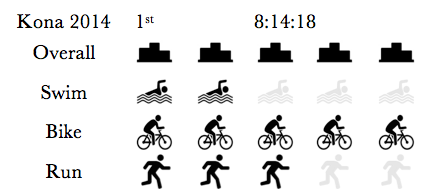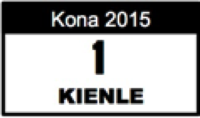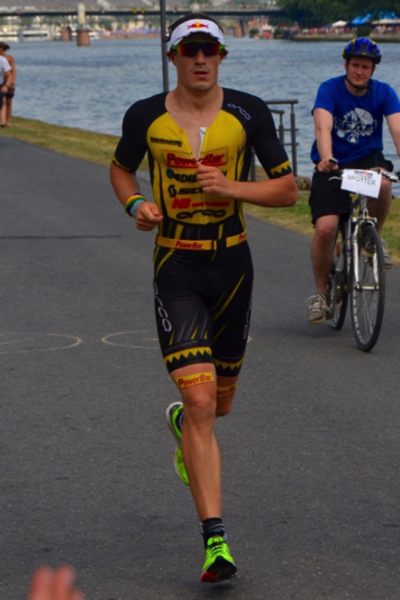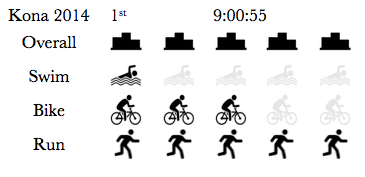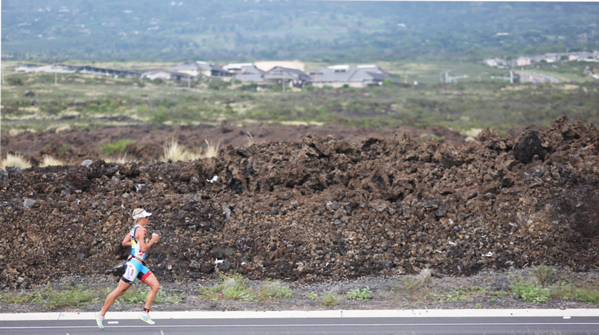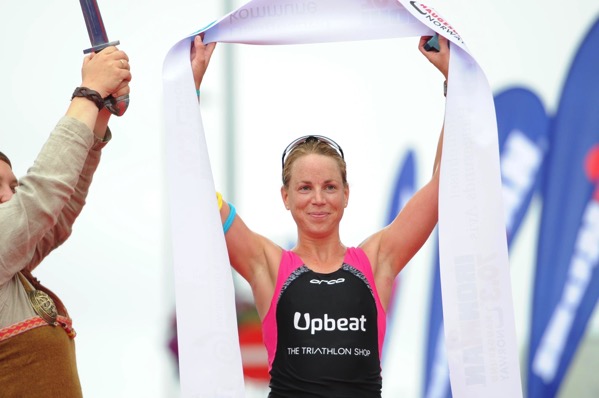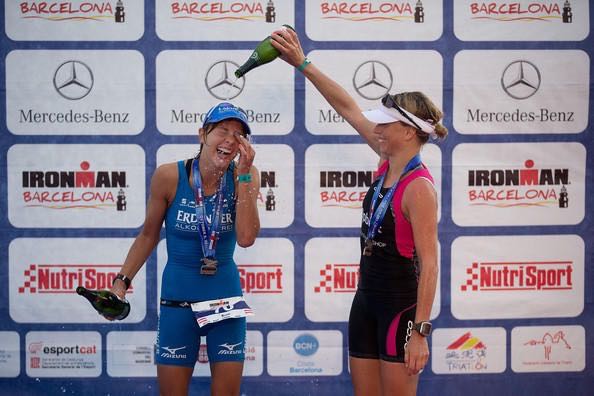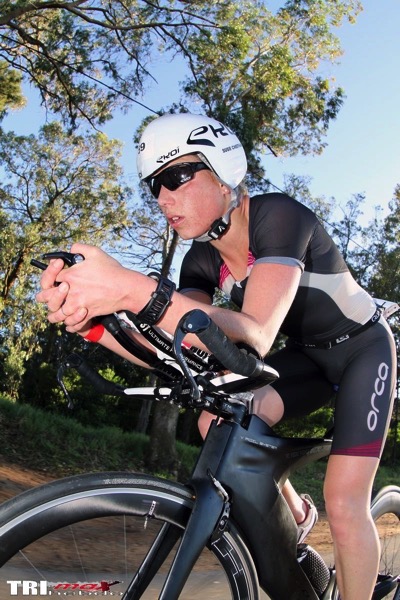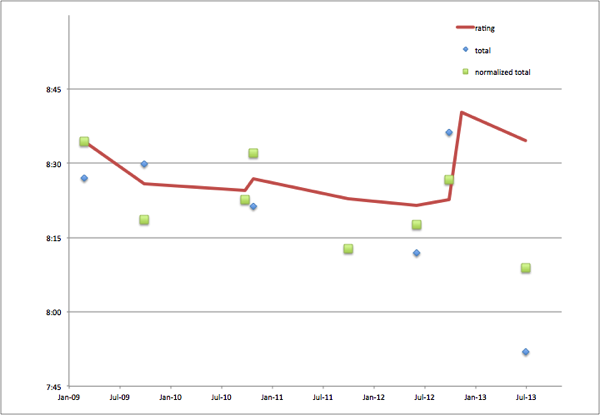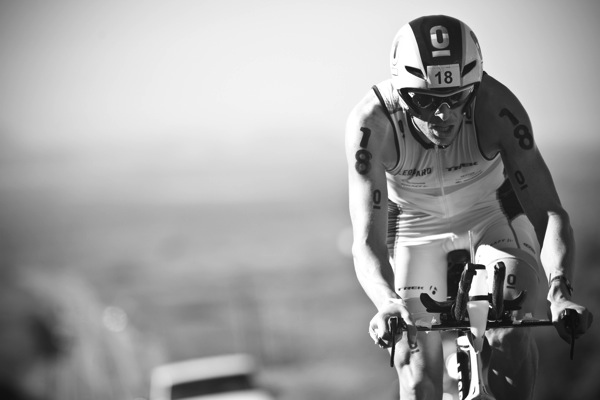Intro
One of the surprises in the women’s Top 10 in Kona 2014 was a relatively unknown German: Julia Gajer. Julia has had some great results in Roth, but waited until September 2013 to race her first “official” Ironman in Wales. She followed that up with her first IM win at IM Arizona in November 2013 (running down Meredith Kessler). She raced Kona for the first time in 2014 and finished her first World Championships in a great 6th place. We’ve had a few chats about where she is coming from, how she developed to the level she is at now and how she wants to get even better. Julia is definitely one of the women to watch for in Frankfurt on July 5th and later in the year in Kona.
Getting into Triathlon
Julia got interested in Triathlon during her time at University: “I grew up being a swimmer but didn’t have the talent to qualify for German or International Championships. During my time at university (I studied Pharmacy) I had a few years of not doing any sports before I started to run by myself just once or twice a week. I then ran with a group of other students. Some of them were triathletes and when I mentioned my swimming background they talked me into my first triathlon.” Her father Werner adds: “When she had registered for her first tri, she borrowed my race bike to try it out and a few days later got her first bike off eBay.” Julia still remembers her first triathlon in 2008 well: “The race was a big adventure. The swim was without a problem but on the bike there was a thunderstorm and it started hailing. I wasn’t sure if I should look for a dry place, but I went on. The run was a really muddy affair after all the rain!” Werner also remembers that she was so fast that the announcer had to be notified by spectators that the first woman was approaching!
After that first race, she was hooked: “In 2009/10 I raced Olympic distance races in the Baden-Württemberg Liga, some half distances (70.3 Wiesbaden 2010, 5th place) and Powerman Zofingen 2009 (4th place), while working full time in a lab on my PhD thesis.” She also ran two good stand-alone marathons in 2:47, winning Luzern Marathon in 2010 and finishing 2nd in the Munich Marathon 2011. “I wasn’t focused on Ironman-distance Triathlon at that point, I was just trying out a few things. The marathons really hurt and I thought I’d never be able to do that after 180k on the bike. But in an Ironman the marathon is hard in a completely different way.”
Julia was racing as an Elite almost from the start and worked on creating a more professional environment. “In 2011 I became part of the Team Erdinger Alkoholfrei Junior team, which helped me quite a lot to develop as an athlete. We got the chance to train with the professional team and pick up a lot of stuff. In 2011 I did my first long distance race in Roth. I didn’t think about placing somewhere close to the front, I was still working full-time and hadn’t thought about doing triathlon as a true professional. I was just going there to finish, have a good race and see where I would end up. I was fourth coming off the bike and totally happy. Then I was able to overtake Belinda Granger who is a legend in Roth. It was my first start over the long distance, I couldn’t believe I was third. Then I heard that Rebekah Keat was having problems and I might have a chance to catch her. I think it was at 37k where I manage to move into second place [eventually finishing in 8:56]. At the end of 2011 I was able to successfully complete my PhD, turned full-time Pro and became a member of the Team Erdinger Alkoholfrei Professional team.”
Julia is one of a large number of female professionals that have a strong background outside of the sport. (There is a large number of PhDs, MDs, MBAs and lawyers in the Kona WPRO field.) Some say that this doesn’t make you quite as hungry to do well in triathlon, but she views this as a plus: “I love to race with a all I have. Being able to return into a decent paying job takes a bit of pressure away as I have a long term alternative. But it doesn’t change anything short term – I might be able to have a more stable income in the pharmaceutical industry, but it won’t be as interesting or exciting.”
Early Pro Years 2012/13
After her impressive Ironman-distance debut and switch to being a full-time Pro, Julia extended her streak of good results in 2012: A couple of wins in 70.3 races, another sub-9 in Roth (this time 3rd in 8:57), a 3rd in the European 70.3 Championships in Wiesbaden and an 8th place at 70.3 World in Henderson, Nevada.
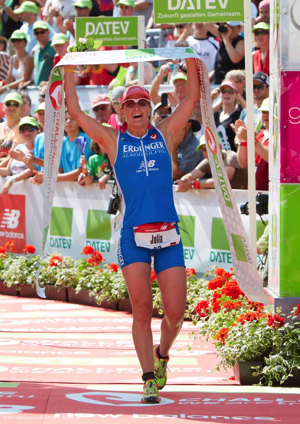
But she already had her sights set on Kona: “After my first IM-distance finish in Roth 2011, I was thinking about racing in Kona. I was able to fly over to watch the race and explore the course in 2012 which was really important. From the first glimpse on television, it doesn’t look too hard. But if you are on the course yourself it really is tough and honest, a real World Championship course. The heat and the wind make it even more challenging, especially on the run. I think that you really need to be ready to race well Kona. I wanted to be in shape for a Top10 finish, but I also needed to be mentally ready to deal with the heat, the wind and the strong field. When I flew over in 2012, my plan was to qualify for 2013, but when I watched the race with palms swaying in the wind and after training on the course, I felt that my mind and body were not yet ready for the race. I decided not to try to qualify for 2013 and to wait another year. I’m sure I would have been able to finish, but I would have struggled on the bike. It costs a lot of money to get there, and finishing 35th doesn’t help you or your sponsors.”
In 2013, she was focusing more and more on races with strong fields, racing 70.3s in Oceanside and St. George. In the summer, she finished her third Challenge Roth, again in 3rd place and with a new PR of 8:51:04. At this point, she had finished (and won) a large number of 70.3s and had three sub-9 finishes in Roth. The Erdinger Alkoholfrei Team provided a professional environment allowing her to focus on training and racing. She also has the support of her whole family on and off the course: Husband Markus, mother Astrid, father Werner, brother Moritz and sister Katja are her biggest fans. She now felt ready for the next step in her career: Racing the Ironman World Championships in Kona.
Qualifying for Kona 2014
But before she was able to race in Kona, she first had to qualify. The first step was to race Ironman Wales in September 2013. “I wanted to start with an early race so I had the option to do another Ironman in 2013. IM Lake Tahoe would have been an alternative, but I had zero experience racing at altitude so Wales seemed the safer route.
“Compared to Roth, Wales is a completely different race. Roth is a very fast course, but the bike course in Wales is very challenging. I think it might be even harder than Lanzarote, there are no long ascents as up to Mirador del Rio but a lot of shorter, steeper climbs and the road surface is pretty rough. And the run course isn’t flat either, running through the village it’s all uphill. But I knew that beforehand, and I believe that hard bike courses are good for me as I’ve always raced well when there are hilly bike courses. But I’ve had two flats and had to wait 20 minutes for tech support to get me a new wheel. I was really cold by then, still finished fourth, but it wasn’t a good start for my Hawaii qualifying.”
Only two months later, she was back on the start line of another Ironman race, this time in Arizona. She didn’t have any problems on the bike this time but was still ten minutes behind race leader Meredith Kessler in T2. She then went on to have a the best marathon of the day (3:02), moved into 2nd place by the half marathon mark and finally took the lead 3k before the finish line. Her first Ironman win gave her enough Kona qualifying points to make getting to Kona a reasonable goal. But with 2.960 points she was still well short of the projected 4.800 points cutoff for July, and it was obvious she needed another big result to be able to qualify.
After taking a break and a new build period, she settled on another US race: Ironman Texas in May. This time she was the one taking the lead on the bike and being hunted on the run. She didn’t quite have the run legs as in Arizona (her Texas run split was 3:09), and Kelly Williamson had a fantastic 2:54 marathon to win the race. Julia had to settle for second place, finishing in 9:00:51 and barely missing the 9 hour mark. This 2nd place improved her KPR score to 4.560, so she still needed a few more points.
She was able to get these last remaining points at one of her home races. The organizers of “Challenge Kraichgau” were bought by WTC. After a long and heated discussion between everyone involved it was decided that Kraichgau would still be a Challenge race in 2014 (the race would be re-branded as 70.3 Kraichgau in 2015) but also offer KPR points. (To the best of my knowledge, this is the only time this ever happened.) Just four weeks after Texas, Julia won Kraichgau with a very strong performance on the run, beating Gina Crawford and Yvonne Van Vlerken. She finally had enough points for a July slot!
This allowed her to race once more in Roth. Celebrating the 30th anniversary, Roth had assembled a great field, including Mirinda Carfrae, Rachel Joyce, Caroline Steffen and Yvonne Van Vlerken. After a good swim (exiting right behind Caroline and in front of Rachel), she struggled a bit on the bike, but a good run allowed her to finish fifth behind the other four. She was hoping to mix it up with the “Big 4” so the race was not what she was looking for, but it showed her that she could have a good result even if she doesn’t have the perfect day.
Kona 2014
Going into Kona 2014, there wasn’t too much of a spotlight on Julia. Of course she was interviewed by the German magazines and sites, but her obligations in the days before the race were limited. “I was pretty much in my own world, looking forward to have a really good race and see where I would end up. I’ve said to a few people that I thought on a good day a Top 10 was possible for me, but the pressure I felt was mainly from my own expectations. Also it was my first start in Kona, and there’s a lot you can’t learn from watching a race, you don’t really have an idea what it’s like until you’re in the race.
“I was pretty optimistic for a non-wetsuit swim. I ended up in a pretty big group, and I couldn’t manage to swim away from them. I wasn’t swimming hard, just being dragged along in the group. I didn’t really have any feel for the water. Maybe it was because the conditions changed the day before the race. Until then there was hardly any wind and we had a flat ocean with no waves. On race day there was a pretty big swell. In Roth I was three minutes ahead of Mirinda, but in Kona we came out at the same time.
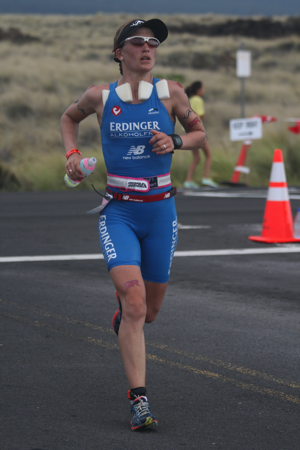
“So it wasn’t a good start but other than in Roth I kept focused on my own race. I didn’t really try to pace off anyone, I was just focused on riding the watts that I had trained for. The longer the race was going on, the better things were going for me. Maybe for the first time ever, I had good legs in the last 60k on the bike.
“At the start of the marathon I was 9th. It felt relatively cool and I started to think who was in front of me and how far back the good runners behind me were.” Julia was able to run well: She didn’t loose any spots on the run and ran down Meredith Kessler and Heather Wurtele. Shortly after mile 22 she also overtook Mary Beth Ellis and moved into 6th place, running a 3:04 marathon and finishing her first Kona Ironman in 9:16.
She was happy with the result, but her assessment is typical for her: “Kona was good, but not perfect.” In a different context she said “I am someone who thinks a lot, going through everything five times over and sometimes being a bit critical.” To me, this is one of her strengths: Because she questions everything, she is very well prepared for almost every situation. While she clearly sees where she can improve, she also knows her strengths in comparison to others and rarely looses her head in the heat of a race. Her father Werner puts it this way: “Her motto is that the race isn’t over until the finish line. She trusts herself and her strengths to let other go on the bike and then manage the difference.”
2015 Season: Switching Coaches and Building towards Frankfurt
After her great result in Kona, Julia made a big change: She switched coaches. Basically since she started Triathlon, she was working with Jochen Frech, the long time head coach of her triathlon club, AST Süßen. Jochen helped her develop from the rookie on the AST Süßen team to a world class long distance triathlete. Nonetheless, she decided to work with Wolfram Bott after Kona. Wolfram has been working as a national coach for the German and Luxemburg federations and he is also coaching a number of successful long-course athletes such as Christian Brader, the Raelert Brothers, or Nils Frommhold.
“There were a number of reasons for switching coaches: I wanted to continue to develop as an athlete and I also think I needed some changes in my training. I was also looking for a more professional environment – including personal presence – at races and for important training sessions.”
When she explains these reasons, it’s obvious that Julia has though long and hard about making this change. When speaking to her in May, she seems glad to have made the change: “I think I’ve already made a few steps forward. In the spring I was able to have three training camps with Wolfram’s group. It was very motivating to train in a group, it’s much easier to get through a hard block as a group. Wolfram was able to see me on a daily basis, so we were able to better adjust my training than via phone or email. Even when training in a group, he makes sure to have time for everyone. He tries to organize sessions so he is able to attend everyone’s key session. I don’t think he has much time off when we’re in a camp. But he lives for the sport and puts all his energy into it. You can call him day and night if you have a problem.
“My training changed a lot, I’ve done a lot of short hard work with some Olympic Distance athletes but we also upped the volume. There were also long brick sessions that I hadn’t done before.”
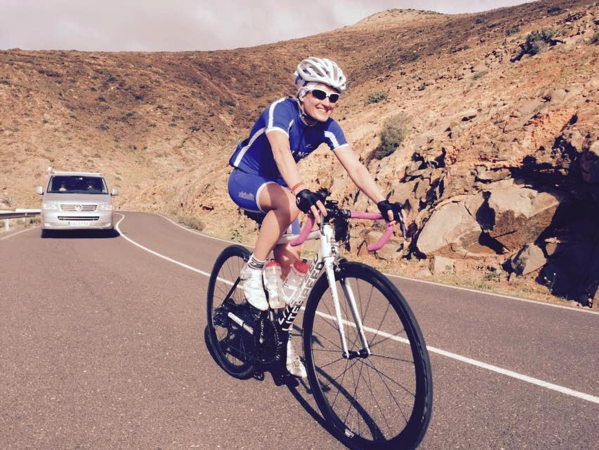
Wolfram adds some details: “There aren’t too many female athletes that can run around three hours on a regular basis, but she needs another ten minutes or so on the bike. So if Julia has any weakness then it’s on the bike and that’s where we put our focus. We’ve increased the frequency of her bike session, so now she’s riding four or five times a week. She wasn’t used to doing multiple sessions a day, now she’s often doing two or three sessions per day and her overall volume increased as well. We’ve also started to work on her bike position. She has a more aggressive setup now, but she says she’s still pretty comfortable.”
Both Julia and Wolfram are taking on a long term view. Julia say, “Such a change always includes risks. It might take a while before the body is able to handle the volume, so I might end up taking a step backwards for a bit. But I believe that working with Wolfram is an important step towards my dream of a Kona podium.” Wolfram adds “When you change the training it usually takes a while before the body adapts to it. I’d be happy if she’s racing on the same level as in the previous years. But I expect a step forward in 2016.”
Julia’s first race of the 2015 season was 70.3 Mallorca: “I had to work hard all day. I was really looking forward to the climb up to Lluc Monastery. I have done a lot of training sessions there but it was so hard going up there in the race. The run didn’t feel much better, maybe I just needed to clear the cobwebs in my first race of the season.” This assessment is typical Julia, she actually finished 2nd behind Daniela Ryf and was in front of athletes such as Yvonne van Vlerken, Tine Deckers, Michelle Vesterby or Kristin Möller. She finished her next race – the “home race” 70.3 Kraichgau – in 2nd place as well. This time Camilla Pedersen was faster, but Julia felt better about the race: She improved her bike split by four minutes compared to last year where she won the race. Everything went really well in her 3rd race, 70.3 Luxembourg. She posted the fastest times in all three legs and won her first race of the season.
Outlook
Julia appears to be on a good progression towards her first big race of the season, the European Championships in Frankfurt on July 5th. After her Kona result, she is in a comfortable position for Kona qualifying; she only needs to finish the race for a July slot. However, she has bigger goals for the race: “Frankfurt is my first A race for the season, and it’s definitely not a race I just want to finish for my Kona slot. My goal is to finish on the podium.” She’s the main German contender in the field headlined by the “showdown” of the two Swiss athletes Daniela Ryf and Caroline Steffen. But she’s not content with 3rd place: “Over the 70.3 distance Daniela was in another league, but an Ironman is a different thing. I’m pretty sure that Daniela will shoot for a new bike course record [currently 4:44 by Natascha Badmann] and also the overall record [8:51:24 by Chrissie Wellington]. The last few years there were a few times I was close to Caroline. If I have a good race, maybe I can tease them a bit. Maybe I can post a new personal best over the Ironman distance [currently 8:51:04] and I’m also targeting to run sub-3. But the run course in Frankfurt is pretty slow, all the bridge ramps will hurt in the third and fourth loop.”
The field in the Regional Championships is always deep, and she’s aware she can easily finish further behind: “There are going to be a lot of fast girls, and beating them won’t be easy.” Among these athletes are Kristin Möller, Sonja Tajsich or Astrid Ganzow (Stienen) that would love to be the top German finisher. There’s also a big group looking for a good result to qualify for Kona including Michelle Vesterby, Tine Deckers, or Ruth Brennan-Morrey. (To have a look at the full Pro field, check out my predictions post for Frankfurt.)
She hasn’t decided how her final Kona prep will look like. “In 2014 I was training at home and flew to Kona two weeks before the race. This year I’ll probably join Wolfram’s group [last year they prepared in Clearmont, Florida after the 70.3 Worlds], but we’ll figure out the details after Frankfurt.”
Obviously, the focus of her season is Kona. “I want to have my best and strongest 2015 race in Kona. I’m not sure what I’ll be able to do, there is so much changing in the female races! Last year most of the pressure came from me, this year it’ll be a different story. A lot would have to happen for me to finish on the podium, my main goal is to have another focused and mentally strong race. I’ll be satisfied if I have given everything, even if I end up in 8th or 10th place. Things are so close between 6th and 15th place and a few minutes can make a big difference.
“Looking beyond 2015 .. the Kona podium is a big goal, and winning the race would be an absolute dream. After this year I’ll have a better picture if I have the confidence to go for it.”
PhotoCredits: Privatbrauerei ERDINGER Weißbräu (Roth Finish), Markus Gajer (Kona Run), Wolfram Bott (Training on the bike)
